本篇文章给大家带来的内容是介绍MySQL表与表之间有什么关系?表与表的多种关系。有一定的参考价值,有需要的朋友可以参考一下,希望对你们有所帮助。
表与表之间的关系
表1 foreign key 表2 则表1的多条记录对应表2的一条记录,即多对一 利用foreign key的原理我们可以制作两张表的多对多,一对一关系多对多: 表1的多条记录可以对应表2的一条记录 表2的多条记录也可以对应表1的一条记录 一对一: 表1的一条记录唯一对应表2的一条记录,反之亦然 分析时,我们先从按照上面的基本原理去套,然后再翻译成真实的意义,就很好理解了
1、先确定关系
2、找到多的一方,把关联字段写在多的一方
一对多
多对一或者一对多(左边表的多条记录对应右边表的唯一一条记录)
需要注意的:
1.先建被关联的表,保证被关联表的字段必须唯一。
2.在创建关联表,关联字段一定保证是要有重复的。
示例:
这是一个书和出版社的一个例子,书要关联出版社(多个书可以是一个出版社,一个出版社也可以有好多书)。
谁关联谁就是谁要按照谁的标准。

创建表
书要关联出版社 被关联的表 create table press(id int primary key auto_increment, name char(20)); 关联的表 create table book( book_id int primary key auto_increment, book_name varchar(20), book_price int, press_id int, constraint Fk_pressid_id foreign key(press_id) references press(id) on delete cascade on update cascade );
插入数据
insert into press(name) values('新华出版社'), ('海燕出版社'), ('摆渡出版社'), ('大众出版社'); insert into book(book_name,book_price,press_id) values('Python爬虫',100,1), ('Linux',80,1), ('操作系统',70,2), ('数学',50,2), ('英语',103,3), ('网页设计',22,3);
运行结果
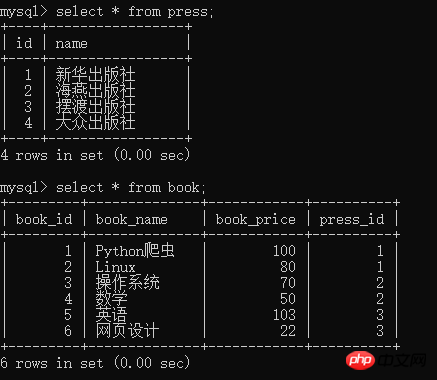
一对一
示例一:
用户和管理员(只有管理员才可以登录,一个管理员对应一个用户)
管理员关联用户

创建表
先建被关联的表 create table user( id int primary key auto_increment, #主键自增name char(10) ); 再建关联表 create table admin( id int primary key auto_increment, user_id int unique, password varchar(16), foreign key(user_id) references user(id) on delete cascade on update cascade );
插入数据
insert into user(name) values('susan1'),('susan2'),('susan3'),('susan4')('susan5'),('susan6'); insert into admin(user_id,password) values(4,'sds156'),(2,'531561'),(6,'f3swe');
运行结果
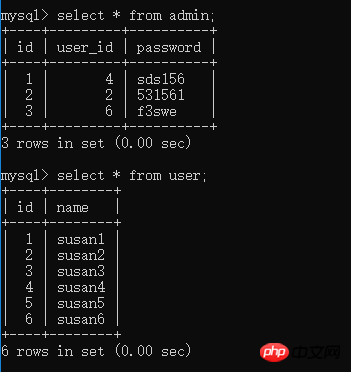
示例二:
学生表和客户表

创建表
create table customer( id int primary key auto_increment, name varchar(10), qq int unique, phone int unique ); create table student1( sid int primary key auto_increment, course char(20), class_time time, cid int unique, foreign key(cid) references customer(id) on delete cascade on update cascade );
插入数据
insert into customer(name,qq,phone) values('小小',13564521,11111111),('嘻哈',14758254,22222222),('王维',44545522,33333333),('胡军',545875212,4444444),('李希',145578543,5555555),('李迪',754254653,8888888),('艾哈',74545145,8712547),('啧啧',11147752,7777777); insert into student1(course,class_time,cid) values('python','08:30:00',3),('python','08:30:00',4),('linux','08:30:00',1),('linux','08:30:00',7);
运行结果
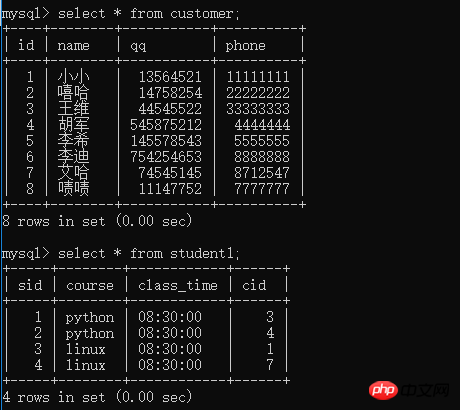
多对多
书和作者(我们可以再创建一张表,用来存book和author两张表的关系)
要把book_id和author_id设置成联合唯一
联合唯一:unique(book_id,author_id)
联合主键:alter table t1 add primary key(id,avg)
多对多:一个作者可以写多本书,一本书也可以有多个作者,双向的一对多,即多对
关联方式:foreign key+一张新的表
示例:
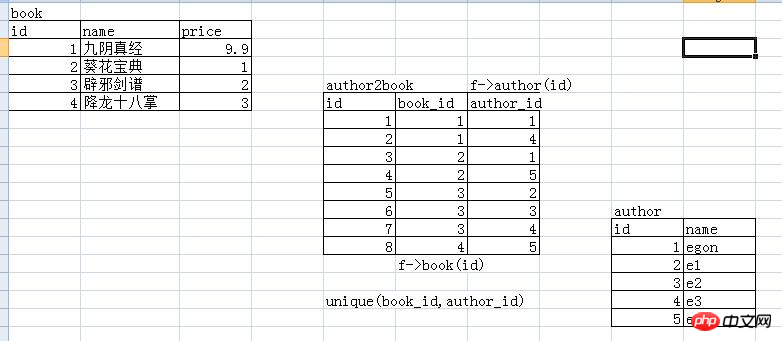
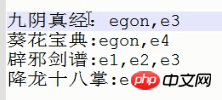
创建表
========书和作者,另外在建一张表来存书和作者的关系 #被关联的 create table book1( id int primary key auto_increment, name varchar(10), price float(3,2) ); #========被关联的 create table author( id int primary key auto_increment, name char(5) ); #========关联的 create table author2book( id int primary key auto_increment, book_id int not null, author_id int not null, unique(book_id,author_id), foreign key(book_id) references book1(id) on delete cascade on update cascade, foreign key(author_id) references author(id) on delete cascade on update cascade );
插入数据
insert into book1(name,price) values('九阳神功',9.9), ('葵花宝典',9.5), ('辟邪剑谱',5), ('降龙十巴掌',7.3); insert into author(name) values('egon'),('e1'),('e2'),('e3'),('e4'); insert into author2book(book_id,author_id) values(1,1),(1,4),(2,1),(2,5),(3,2),(3,3),(3,4),(4,5);
多对多关系举例
用户表,用户组,主机表
创建三张表
-- 用户表 create table user (id int primary key auto_increment,username varchar(20) not null,password varchar(50) not null); insert into user(username,password) values('egon','123'),('root',147),('alex',123),('haiyan',123),('yan',123); -- 用户组表 create table usergroup(id int primary key auto_increment,groupname varchar(20) not null unique); insert into usergroup(groupname) values('IT'),('Sale'),('Finance'),('boss'); -- 主机表 CREATE TABLE host(id int primary key auto_increment,ip CHAR(15) not NULL UNIQUE DEFAULT '127.0.0.1'); insert into host(ip) values('172.16.45.2'),('172.16.31.10'),('172.16.45.3'),('172.16.31.11'),('172.10.45.3'), ('172.10.45.4'),('172.10.45.5'),('192.168.1.20'),('192.168.1.21'),('192.168.1.22'),('192.168.2.23'),('192.168.2.223'), ('192.168.2.24'),('192.168.3.22'),('192.168.3.23'),('192.168.3.24');
建立关系
-- 建立user和usergroup的关系表 create table user2usergroup( id int not NULL UNIQUE auto_increment, user_id int not null, group_id int not NULL, PRIMARY KEY(user_id,group_id), foreign key(user_id) references user(id) ON DELETE CASCADE on UPDATE CASCADE , foreign key(group_id) references usergroup(id) ON DELETE CASCADE on UPDATE CASCADE ); insert into user2usergroup(user_id,group_id) values(1,1),(1,2),(1,3),(1,4),(2,3),(2,4),(3,4); -- 建立user和host的关系 create table user2host( id int not null unique auto_increment, user_id int not null, host_id int not null, primary key(user_id,host_id), foreign key(user_id) references user(id), foreign key(host_id) references host(id) ); insert into user2host(user_id,host_id) values(1,1),(1,2),(1,3),(1,4),(1,5),(1,6),(1,7),(1,8),(1,9),(1,10),(1,11),(1,12),(1,13),(1,14),(1,15),(1,16),(2,2),(2,3),(2,4),(2,5),(3,10),(3,11),(3,12);
Atas ialah kandungan terperinci MySQL表与表之间有什么关系?表与表的多种关系. Untuk maklumat lanjut, sila ikut artikel berkaitan lain di laman web China PHP!
 Terangkan sifat asid (atom, konsistensi, pengasingan, ketahanan).Apr 16, 2025 am 12:20 AM
Terangkan sifat asid (atom, konsistensi, pengasingan, ketahanan).Apr 16, 2025 am 12:20 AMAtribut asid termasuk atom, konsistensi, pengasingan dan ketahanan, dan merupakan asas reka bentuk pangkalan data. 1. Atomicity memastikan bahawa urus niaga sama ada berjaya atau gagal sepenuhnya. 2. Konsistensi memastikan pangkalan data tetap konsisten sebelum dan selepas transaksi. 3. Pengasingan memastikan bahawa urus niaga tidak mengganggu satu sama lain. 4. Kegigihan memastikan data disimpan secara kekal selepas penyerahan transaksi.
 MySQL: Sistem Pengurusan Pangkalan Data vs Bahasa PengaturcaraanApr 16, 2025 am 12:19 AM
MySQL: Sistem Pengurusan Pangkalan Data vs Bahasa PengaturcaraanApr 16, 2025 am 12:19 AMMySQL bukan sahaja sistem pengurusan pangkalan data (DBMS) tetapi juga berkait rapat dengan bahasa pengaturcaraan. 1) Sebagai DBMS, MySQL digunakan untuk menyimpan, menyusun dan mengambil data, dan mengoptimumkan indeks dapat meningkatkan prestasi pertanyaan. 2) Menggabungkan SQL dengan bahasa pengaturcaraan, tertanam dalam Python, menggunakan alat ORM seperti SQLalChemy dapat memudahkan operasi. 3) Pengoptimuman prestasi termasuk pengindeksan, pertanyaan, caching, perpustakaan dan bahagian meja dan pengurusan transaksi.
 MySQL: Menguruskan data dengan arahan SQLApr 16, 2025 am 12:19 AM
MySQL: Menguruskan data dengan arahan SQLApr 16, 2025 am 12:19 AMMySQL menggunakan arahan SQL untuk menguruskan data. 1. Perintah asas termasuk pilih, masukkan, kemas kini dan padam. 2. Penggunaan lanjutan melibatkan fungsi gabungan, subquery dan agregat. 3. Kesilapan umum termasuk isu sintaks, logik dan prestasi. 4. Petua Pengoptimuman termasuk menggunakan indeks, mengelakkan Pilih* dan menggunakan had.
 Tujuan Mysql: Menyimpan dan Menguruskan Data dengan berkesanApr 16, 2025 am 12:16 AM
Tujuan Mysql: Menyimpan dan Menguruskan Data dengan berkesanApr 16, 2025 am 12:16 AMMySQL adalah sistem pengurusan pangkalan data relasi yang sesuai untuk menyimpan dan menguruskan data. Kelebihannya termasuk pertanyaan berprestasi tinggi, pemprosesan transaksi fleksibel dan jenis data yang kaya. Dalam aplikasi praktikal, MySQL sering digunakan dalam platform e-dagang, rangkaian sosial dan sistem pengurusan kandungan, tetapi perhatian harus dibayar kepada pengoptimuman prestasi, keselamatan data dan skalabilitas.
 SQL dan MySQL: Memahami hubunganApr 16, 2025 am 12:14 AM
SQL dan MySQL: Memahami hubunganApr 16, 2025 am 12:14 AMHubungan antara SQL dan MySQL adalah hubungan antara bahasa standard dan pelaksanaan khusus. 1. SQL adalah bahasa standard yang digunakan untuk mengurus dan mengendalikan pangkalan data relasi, membolehkan penambahan data, penghapusan, pengubahsuaian dan pertanyaan. 2.MYSQL adalah sistem pengurusan pangkalan data tertentu yang menggunakan SQL sebagai bahasa pengendaliannya dan menyediakan penyimpanan dan pengurusan data yang cekap.
 Terangkan peranan log redo innoDB dan membatalkan log.Apr 15, 2025 am 12:16 AM
Terangkan peranan log redo innoDB dan membatalkan log.Apr 15, 2025 am 12:16 AMInnoDB menggunakan redolog dan undologs untuk memastikan konsistensi dan kebolehpercayaan data. 1. Pengubahsuaian halaman data rekod untuk memastikan pemulihan kemalangan dan kegigihan transaksi. 2.UNDOLOGS merekodkan nilai data asal dan menyokong penggantian transaksi dan MVCC.
 Apakah metrik utama untuk dicari dalam output yang dijelaskan (jenis, kunci, baris, tambahan)?Apr 15, 2025 am 12:15 AM
Apakah metrik utama untuk dicari dalam output yang dijelaskan (jenis, kunci, baris, tambahan)?Apr 15, 2025 am 12:15 AMMetrik utama untuk menjelaskan arahan termasuk jenis, kunci, baris, dan tambahan. 1) Jenis mencerminkan jenis akses pertanyaan. Semakin tinggi nilai, semakin tinggi kecekapan, seperti const adalah lebih baik daripada semua. 2) Kunci memaparkan indeks yang digunakan, dan null menunjukkan tiada indeks. 3) Baris menganggarkan bilangan baris yang diimbas, yang mempengaruhi prestasi pertanyaan. 4) Tambahan memberikan maklumat tambahan, seperti menggunakanFilesort meminta bahawa ia perlu dioptimumkan.
 Apakah status sementara dalam menjelaskan dan bagaimana untuk mengelakkannya?Apr 15, 2025 am 12:14 AM
Apakah status sementara dalam menjelaskan dan bagaimana untuk mengelakkannya?Apr 15, 2025 am 12:14 AMMenggunakanTemary menunjukkan bahawa keperluan untuk membuat jadual sementara dalam pertanyaan MySQL, yang biasanya dijumpai di Orderby menggunakan lajur yang berbeza, GroupBy, atau tidak diindeks. Anda boleh mengelakkan berlakunya indeks dan menulis semula pertanyaan dan meningkatkan prestasi pertanyaan. Khususnya, apabila menggunakan pembelian muncul dalam menjelaskan output, ini bermakna MySQL perlu membuat jadual sementara untuk mengendalikan pertanyaan. Ini biasanya berlaku apabila: 1) deduplikasi atau pengelompokan apabila menggunakan yang berbeza atau kumpulan; 2) Susun apabila Orderby mengandungi lajur bukan indeks; 3) Gunakan subquery kompleks atau menyertai operasi. Kaedah Pengoptimuman termasuk: 1) Orderby dan GroupB


Alat AI Hot

Undresser.AI Undress
Apl berkuasa AI untuk mencipta foto bogel yang realistik

AI Clothes Remover
Alat AI dalam talian untuk mengeluarkan pakaian daripada foto.

Undress AI Tool
Gambar buka pakaian secara percuma

Clothoff.io
Penyingkiran pakaian AI

AI Hentai Generator
Menjana ai hentai secara percuma.

Artikel Panas

Alat panas

MantisBT
Mantis ialah alat pengesan kecacatan berasaskan web yang mudah digunakan yang direka untuk membantu dalam pengesanan kecacatan produk. Ia memerlukan PHP, MySQL dan pelayan web. Lihat perkhidmatan demo dan pengehosan kami.

Penyesuai Pelayan SAP NetWeaver untuk Eclipse
Integrasikan Eclipse dengan pelayan aplikasi SAP NetWeaver.

VSCode Windows 64-bit Muat Turun
Editor IDE percuma dan berkuasa yang dilancarkan oleh Microsoft

SublimeText3 versi Inggeris
Disyorkan: Versi Win, menyokong gesaan kod!

ZendStudio 13.5.1 Mac
Persekitaran pembangunan bersepadu PHP yang berkuasa





